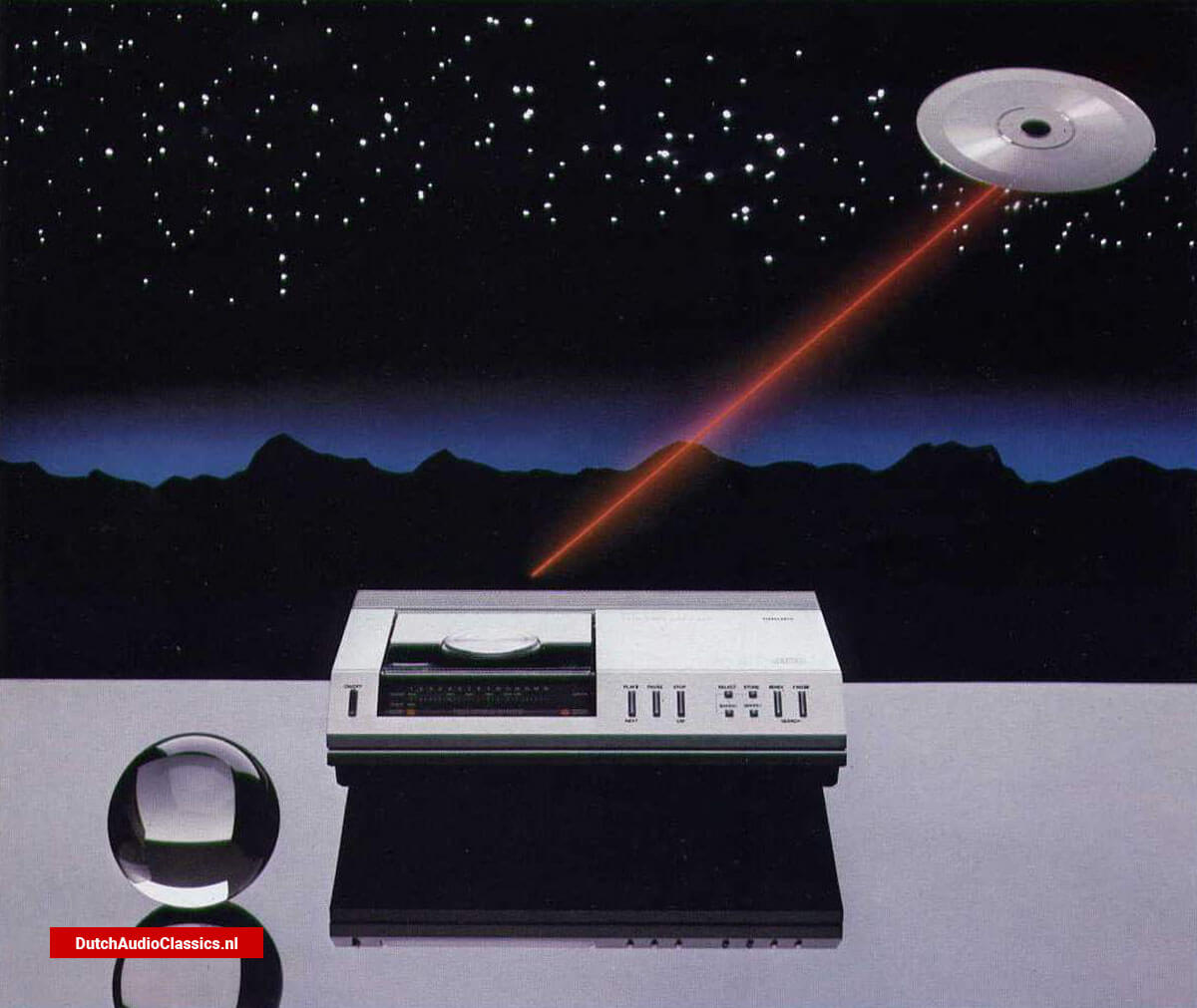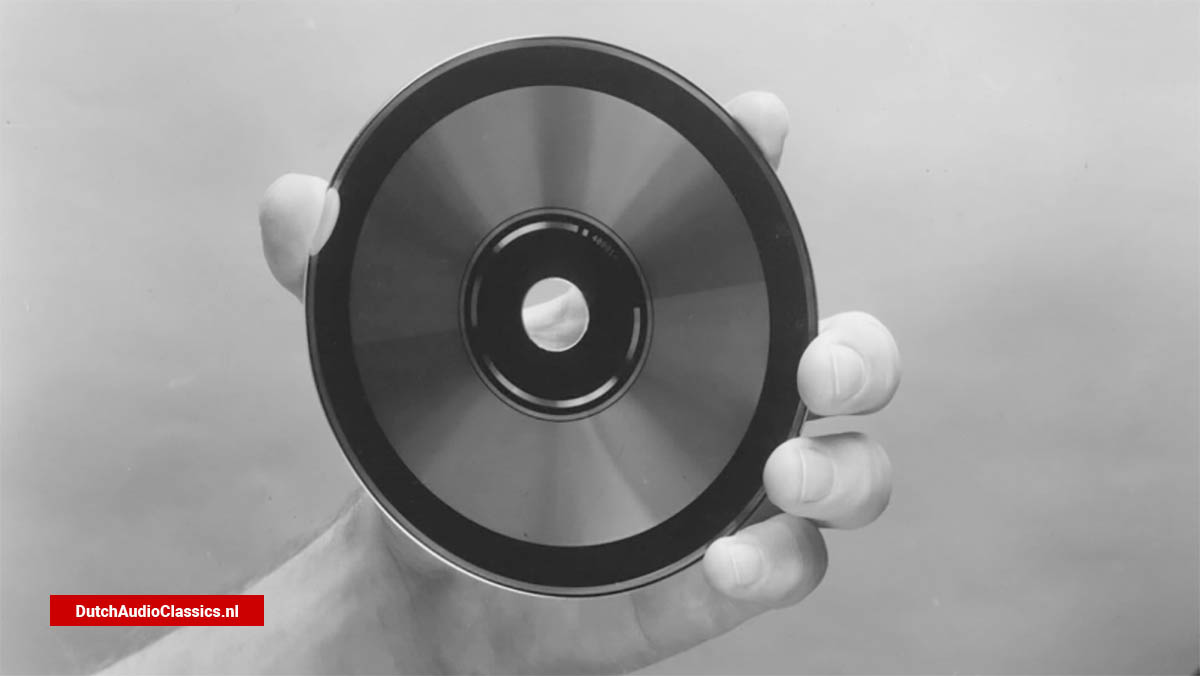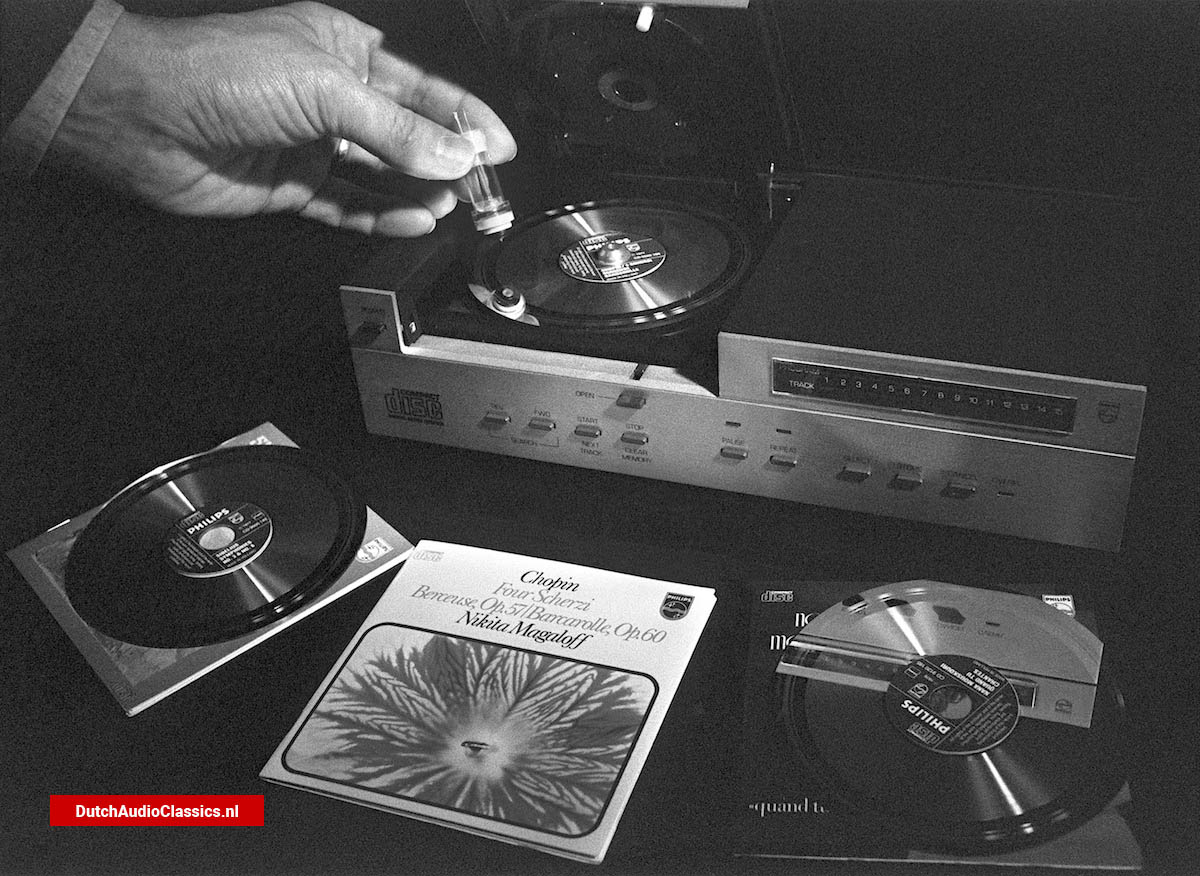Compact Disc is the new digital audio medium that uses advanced computer technology to encode up to around 8O minutes of uninterrupted programme material on a disc only 12 cm in diameter. Unlike the conventional LP record medium, Compact Disc uses a unique, non-contact laser *read-out' system, so there can be no wear of either the disc or the player itself. In other words, there is no deterioration of sound quality no matter how many times a record is played. Compact Disc records are also almost totally immune to dust, scratches and accidental damage during handling, since the recorded signal is actually embedded under the surface of the disc and covered with a protective plastic coating. So the sound duality of Compact Disc really is virtually everlasting!
How that consumer sales of Compact Disc are about to start on the European market, a high level of interest in this revolutionary new audio medium is being shown in the media and among HiFi and audio dealers and enthusiasts.
 Philips CD100
Philips CD100
But what exactly is the history of this new system which has tuddenly become the focus of attention in the HiFi field? Long—term investments
In the late 1960s, Philips decided to make strategic, long-term investments in optical electronics. Three major, and separate, commercial systems were the fruits of the Intensive research programme resulting from that decision. In addition to Compact Disc, the other two of these developments were the Digital Optical Recording (DOR) system which both writes and reads data for archival storage purposes in computerised 'office of the future' environments, making it an advanced, space- and labour- saving filing system; and the well known VLP - Video Long Play - or LaserVision system, for replay of prerecorded video programme material in domestic, educational or commercial applications.
Philips was able to innovate all three of these systems for the simple reason that all three share fundamental technologies like the manufacture of the disc or data carrier, and the laser read-out system for recovery of the - information stored on the disc. The first system to be A launched was VLP, on which activity started in 1969 with the press launch following in August 1972.
Milestone
In fact, digital video and audio technologies have a great deal in common, and digital audio was even referred to as ALP - Audio Long Play - right at the beginning. However, a clear separation was made between the two activities in 1974, so that this year can really be regarded as the first major milestone in the story of Compact Disc. By April 1979, development had reached the stage where the first working system could be shown to the press, and contacts with other hardware and software manufacturers were intensified in that year to lay the basis for what would later become a virtually industry-wide standardisation agreement.
This explains the present heavy involvement in Compact Disc of the major Japanese companies, although it is clear that the system was in fact invented and developed by Philips, in Europe.
However, Europe is no longer the home of HiFi, since the market is to a very large extent influenced by the USA as far as records are concerned, and by Japan for players and other audio equipment. It was therefore abundantly clear that even a company with HB resources of the Philips Group could not hope to follow its own path — especially with a completely new and revolutionary audio system. There was a clear need for a single world standard, to ensure first of all that the new system would in fact receive-the universal adoption that it deserved, and secondly that all records and players using this new medium would be fully compatible and interchangeable, regardless of where they are made. The desire to achieve this aim also benefitted from hindsight, F in that it was considered essential to avoid a repetition of the current situation in the video—recorder market - where no single system has yet emerged as the universal system of choice. Instead, every effort should be made to repeat the success of the Compact Cassette medium, also of course a Philips invention.
Worldwide standard
In fact, Compact Cassette was probably a very important factor in the Compact Disc story, since it indicated beyond doubt the ability of Philips to lay down a worldwide standard. Today, twenty years after the introduction of Compact Cassette, no—one could possibly doubt the truth of this statement, and there can be few places in the world where the audio cassette is not known as a convenient and easily obtainable medium.

with this objective in mind, negotiations started with another major audio company, the Sony Corporation, resulting in an agreement being reached in August 1979. In fact, Sony was a very suitable partner for the Compact Disc system because of its experience in digital recording techniques — a field in which Philips' associated company PolyGram is also extremely active. As a result of this agreement some changes were made to the digital electronics in the areas of modulation and error correction, but otherwise no basic changes were made to the existing Philips system.
By June l98O, with the important advantage of a Japanese system partner, Philips was in a position to submit Compact Disc to the all-important Digital Audio Disc — DAD — committee. At that time, DAD was already considering no less than three different digital audio systems, and its decision would be a crucial factor in the determination of the world—standard system. Even as late as October 1980, at the All Japan Audio Fair, a variety of digital audio disc systems were still being exhibited.
Turning point
A significant turning point was reached only a few months later in January 1981, when the Japanese electronics giant Matsushita announced that it would adopt the Philips Compact Disc system. Showing the importance of this announcement for Compact Disc, it should be remembered that Matsushita's subsidiary JVC was in fact the main promoter of the Audio High Density (AHD) system, which up to then had looked like a possible rival to Compact Disc.
From that moment, there was no longer any doubt that Compact Disc would become the new world standard, and the truth of this statement is reflected in the fact that virtually every major audio manufacturer has joined the list of Compact Disc system partners. Further large-scale support for the system has come from the world record industry, with major companies in Japan, Europe and the USA manufacturing Compact Disc records on a large scale.
Against this background of total acceptance of the Compact Disc system, the question may arise of why it was Philips that came up with the system that has turned out to be the world standard.
Multi—technology breakthrough
In fact, one look at the many different technologies that are combined in Compact Disc makes it clear that Philips is one of the very few manufacturers in the world with the capability of making what is really a multi-technology breakthrough.

Only a company with all those technologies in-house could hope to succeed in such a task. For example, glass is one of the less obvious, but nevertheless vital, technologies underlying Compact Disc. Glass is an essential element of “ the record mastering process - in fact Phi1ips' first prototype VLP disc was made of glass - and of course Philips has a vast reservoir of specialised know-how in the field of glass, which is reflected in areas like television tubes and fibre-optics for use in telecommunications systems.
Also essential is basic recording studio know—how, which Philips could draw on from its ELA — Electro—Acoustical Equipment - Division, which is a major manufacturer of professional audio and studio equipment. This division is also responsible for the disc mastering equipment and processes that form a vital part of the Compact Disc system. Another vital element in Compact Disc is the electronics, and in particular the manufacture of the highly complex, miniature integrated circuits. Philips electronic components division Elcoma was responsible for the big breakthrough in solid—state lasers that enable the Compact Disc player to be made so small and reliable. Vast resources in the semiconductor field are also needed for the development of the VLSI - Very Large Scale Integration - circuits which are another essential part of every Philips Compact Disc player. These ICs are needed to perform the hundreds of thousands of switching operations that take place every second inside a Compact Disc player.
Computer technology is another vital capability area, since the signals derived from a digital audio or video disc are processed in the same basic way as the digital data handled by computers.
'Dedicated computer'
This is particularly true of Compact Disc's modulation and error-correction systems, which have no parallel in conventional audio equipment. In fact, the widespread use of the terms 'hardware' and 'software' in connection with Compact Disc reflect the system's very strong links with computer technology, and Compact Disc can really be regarded as a sort of 'dedicated' computer - dedicated, in this case, to the replay of music which has been recorded in the form of digital 'data‘.
Another technology that it is essential to have in—house is that of telecommunications. This is where the Compact Disc encoding system of Pulse Code Modulation has its roots, and in fact this system started as a transmission technology for telephone traffic and broadcasting.
It goes without saying that Philips has all these technologies available in—house, which should to a large extent explain its pioneering role in the digital audio field.
But as well as having all these different technologies available, Philips also has the massive research and development facilities needed to bring them all together in a working, market—ready system. Philips spent over one billion dollars on R&D in 1980, for example, and there can be few commercial organisations in the world that are capable of making a commitment of this magnitude to staying on top in technology.
Finally, since Compact Disc is a system, rather than a few new pieces of equipment, a capability in the field of music and records is required. This is an essential factor since no—one is interested in buying equipment without the assurance that an adequate selection of record titles are available. Philips' capability in this important area comes from its interest in PolyGram, the European market—leading record company. Actually, PolyGram is one of the top three music and record companies in the world, so it is clearly a well qualified system partner in Compact Disc!
To summarise, the concept of Compact Disc digital audio could only be turned into reality by a company that had at its disposal a number of different technologies: glass, studio recording, mastering, semiconductors, computers, telecommunications and record manufacture, together with the necessary research and development facilities to back them all up.
So while it is clear that digital audio had to happen - in line with all the other digital developments that are taking place in this decade — it needed a company with the technologies and resources of Philips to make it happen.
Philips press information, Eindhoven, 1984
 Philips CD100
Philips CD100

